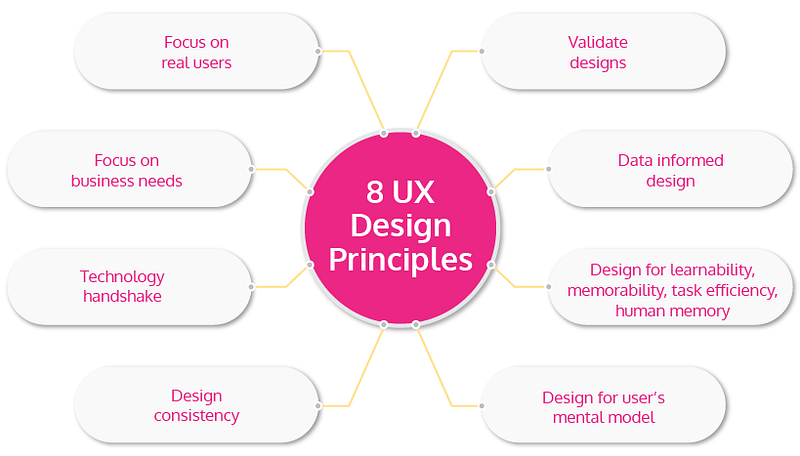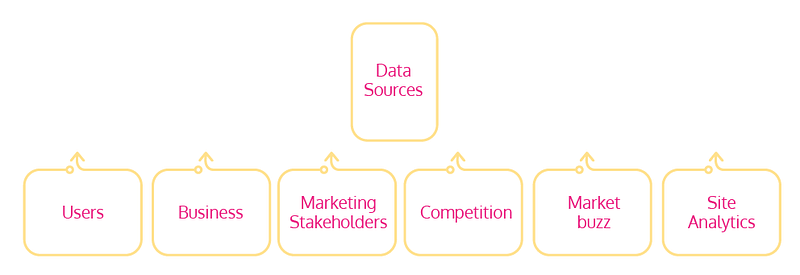8 UX Design Principles That Ensure Seamless User Experience of Your Product
Great user experience increases chances of customers recommending your product by 16.6%.
Such is the impact of UX design on customers. UX design is fast establishing itself as a business differentiator. It is time for businesses to invest in understanding the impact and reach of UX design.
UX design is an art within the boundaries of science that makes business sense and drives ROI for organizations. A seamless UX is about providing meaningful and relevant experiences to customers in order to increase interactions and retention. It can be created with continuous improvement in designs with regards to usability and customer’s perceived Quality.
There are several recipes one can use to make UX Design a success. We as UX company recommend these top 8 UX design principles to create memorable experiences for your customers.

1. Focus on the real customers:
The main goal of any business is to make the end customers happy. The first and foremost, UX design principle is to focus on real customers — their needs, expectations, motivations and frustrations.
A clear understanding of these important user aspects helps designers to build personas, and focus on these personas throughout the design cycle. One can elicit real customers’ needs using a combination of common user research methods such as interviews, focus groups, contextual inquiry and shadowing.
2. Focus on business:
For any product to be successful in the industry, UX design of that product MUST make business sense.
Defining your business goals upfront is extremely important. A good UX design creates a great balance between business and user goals. Making the end customers happy while meeting the business goals will eventually result in high ROI for your business.
3. Data-informed Design:
A design is great not because it is created by a talented designer. When it is informed through insightful data collated from the real customers through user research, the result is always impactful. Designers use data as a source to make effective design decisions. Data can be qualitative or quantitative in nature.
Data sources can be a combination of customers, business and marketing stakeholders, competition, market buzz, and site analytics. Data-informed design will help achieve long-term business goals as well as user goals. It delivers a great experience which will eventually result in user engagement and retention.

4. User’s Mental Model:
User’s mental model means the perception that a user has in her/ his mind about a particular product or service. Once you understand users’ mental models, you can
replicate that in your design to give desired experience, thus making it easy for users to complete their tasks and achieve their goals.
Various research techniques are used to capture data regarding user’s mental model. Card sorting, user interviews and surveys can help you in eliciting information about a user’s mental model. Understanding the functions of your product along with the users’ mental models, enables designers to design better and intuitive user experiences.
5. Learnability, Memorability, Task Efficiency and Human Memory:
One of the important UX design principles includes creating designs that are easy to learn, make users do their tasks efficiently and effectively. These interactions can also provide memorable experiences.
Learnability of the design is based on the user’s understanding of the design. Memorability means, when the user returns to it, he or she should be able to remember how to do things, as users may not be using the application for longer periods of time.
Here, user experience plays a crucial role as a differentiator. When the user has decided to do a task on a website or in an app, then he/she should be able to complete it efficiently which is also achieved with the help of great user experience.
6. Validation of Designs:
Design validation means a detailed evaluation and analysis during and/ or at the end of the design and development phase. The goal of validating designs is to ensure that the design is able to achieve the pre-set goals. Validation of design is useful in improving design decisions and maintaining consistency.
One of the typical techniques used for design validation these days is an expert review. Cognitive walkthroughs, formative and summative usability testing, and A/B testing are some more of these examples.
7. Consistency throughout the Experience:
Consistency is another important UX design principle. Consistency throughout the interaction of a product with a user, is a sign of a good user experience design. It helps customers to get used to the product quickly and reduce the learning time. Design consistency includes maintaining brand voice along with the visual language, increasing the possibility of recall for customers.
If a user encounters inconsistency, the chances of him returning back to your product are less. As inconsistent UX design leads to confusion and disappointment towards the product. The crux being, consistency helps businesses build recall value, credibility and trust about the company.
8. Technology handshake:
Technology is ever-changing, and it is transforming businesses with it. Once you have designs that are validated, tested with the users, all you need to make sure is that whatever you have designed can be handled by the existing technology. The interactions, strategy and visual design envisioned by the designer has to see the light of the day. And that reality is solely possible through a technology handshake.
There are literally hundreds of UX design principles that apply from a micro to a macro level of design. This blog has attempted to focus on macro principles, the over-arching UX design principles that would make your UX efforts successful.
Focusing on real customers, defining and achieving business goals, designing data-informed design, evolving the designs with the ever-changing technology, validating designs by various methods, maintaining consistency, considering user’s mental model before designing will result in making the end customers perform their tasks. This will ensure a seamless user experience.
If you want to create memorable product experiences for your customers, we can deliver design strategies that create a seamless and memorable experience for your customers. We will deliver the value that you truly deserve, through our UX design development service, with the help of UX design principles.
Amplify your brand presence with the best UX design studio that truly aligns your needs with those of your consumers! Get in touch with us at YUJ Designs, today!
Blog source : https://www.yujdesigns.com/8-ux-design-principles-that-ensure-seamless-user-experience-of-your-product/

.webp)
.png)

Comments
Post a Comment